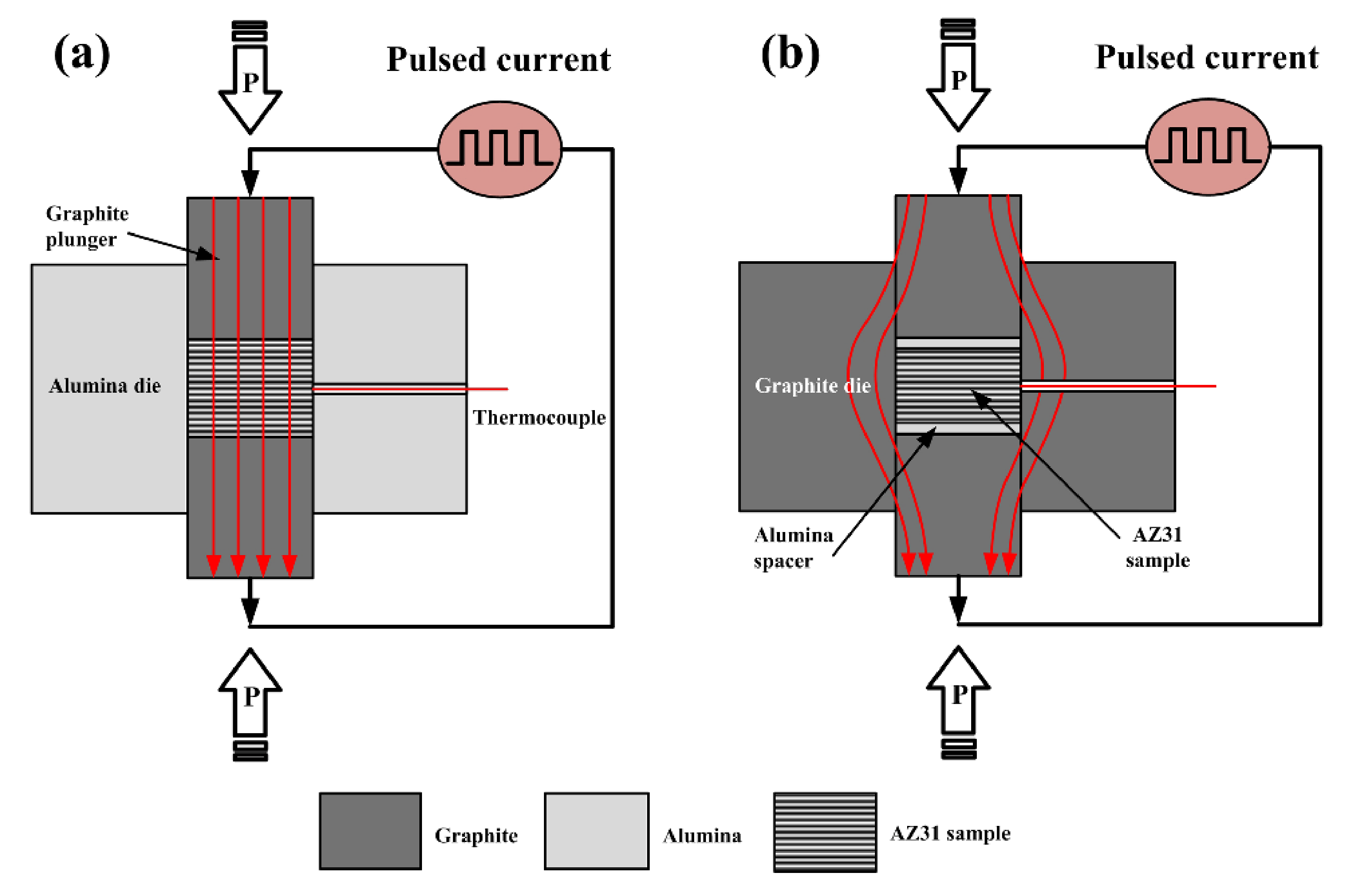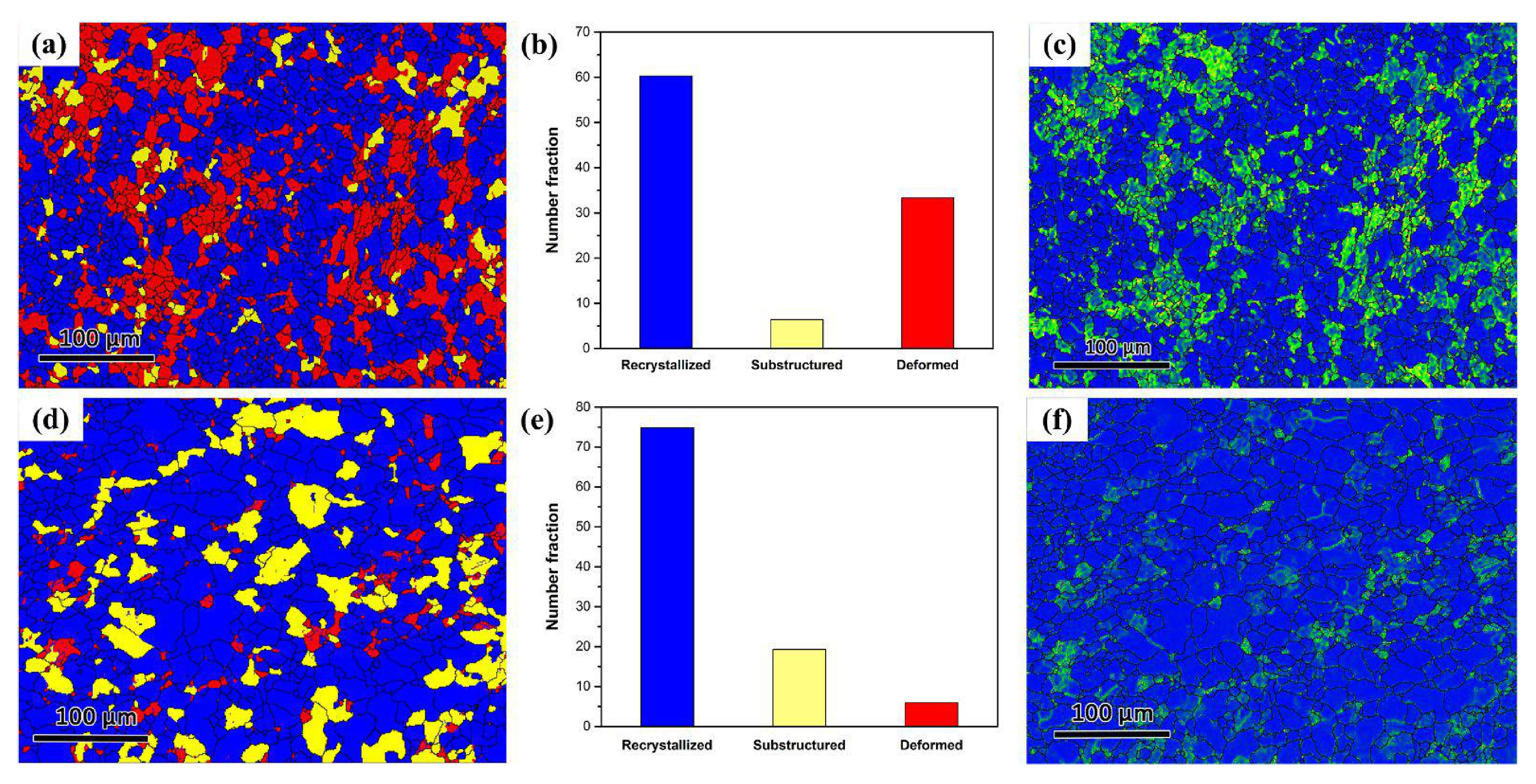Intrinsic Effect of Pulsed Current on the Recrystallization of Deformed AZ31 Alloy
Abstract
:1. Introduction
2. Experimental Section
3. Results and Discussion
4. Conclusions
Author Contributions
Funding
Institutional Review Board Statement
Informed Consent Statement
Data Availability Statement
Conflicts of Interest
References
- Shi, C.; Zhang, K.; Jiang, S.; Huang, Z. Pulse current auxiliary forging of sintered TiAl alloys based on the investigation of dynamic recrystallization and phase transformation. Mater. Charact. 2018, 135, 325–336. [Google Scholar] [CrossRef]
- Jiang, Y.; Guan, L.; Tang, G.; Zhang, Z. Improved mechanical properties of Mg–9Al–1Zn alloy by the combination of aging, cold-rolling and electropulsing treatment. J. Alloys Compd. 2015, 626, 297–303. [Google Scholar] [CrossRef]
- Zhang, C.; Zhang, K.; Wang, G. Superplasticity of fine grained γ-TiAl based alloy synthesized by pulse current auxiliary sintering. Mater. Lett. 2009, 63, 2153–2156. [Google Scholar] [CrossRef]
- Zhang, Z.-H.; Wang, F.-C.; Wang, L.; Li, S.-K. Ultrafine-grained copper prepared by spark plasma sintering process. Mater. Sci. Eng. A 2008, 476, 201–205. [Google Scholar] [CrossRef]
- Chen, Y.; Yu, H.; Zhang, D.; Chai, L. Effect of spark plasma sintering temperature on microstructure and mechanical properties of an ultrafine grained TiAl intermetallic alloy. Mater. Sci. Eng. A 2009, 525, 166–173. [Google Scholar] [CrossRef]
- Feng, P.; He, Y.; Xiao, Y.; Xiong, W. Effect of VC addition on sinterability and microstructure of ultrafine Ti(C, N)-based cermets in spark plasma sintering. J. Alloy. Compd. 2008, 460, 453–459. [Google Scholar] [CrossRef]
- Zhang, Z.; Chen, Y.; Zuo, L.; Zhang, Y.; Qi, Y.; Gao, K.; Liu, H.; Wang, X. In situ synthesis WC reinforced iron surface composite produced by spark plasma sintering and casting. Mater. Lett. 2018, 210, 227–230. [Google Scholar] [CrossRef]
- Garay, J.E.; Glade, S.C.; Anselmi-Tamburini, U.; Asoka-Kumar, P.; Munir, Z.A. Electric current enhanced defect mobility in Ni3Ti intermetallics. Appl. Phys. Lett. 2004, 85, 573–575. [Google Scholar] [CrossRef] [Green Version]
- Kim, B.-N.; Hiraga, K.; Morita, K.; Yoshida, H. Effects of heating rate on microstructure and transparency of spark-plasma-sintered alumina. J. Eur. Ceram. Soc. 2009, 29, 323–327. [Google Scholar] [CrossRef]
- Cui, B.; Sa, R.; Jayaseelan, D.D.; Inam, F.; Reece, M.J.; Lee, W.E. Microstructural evolution during high-temperature oxidation of spark plasma sintered Ti2AlN ceramics. Acta Mater. 2012, 60, 1079–1092. [Google Scholar] [CrossRef] [Green Version]
- Tang, D.W.; Zhou, B.L.; Cao, H.; He, G.H. Thermal stress relaxation behavior in thin films under transient laser-pulse heating. J. Appl. Phys. 1993, 73, 3749–3752. [Google Scholar] [CrossRef]
- Liu, Y.; Fan, J.; Zhang, H.; Jin, W.; Dong, H.; Xu, B. Recrystallization and microstructure evolution of the rolled Mg–3Al–1Zn alloy strips under electropulsing treatment. J. Alloy. Compd. 2014, 622, 229–235. [Google Scholar] [CrossRef]
- Chao, H.; Sun, H.; Chen, W.; Wang, E. Static recrystallization kinetics of a heavily cold drawn AZ31 magnesium alloy under annealing treatment. Mater. Charact. 2011, 62, 312–320. [Google Scholar] [CrossRef]
- Nabarro, F.R.N. Dislocations in Solids; Elsevier: Amsterdam, The Netherlands, 1989. [Google Scholar]
- Chen, Z.H. Wrought Magnesium Alloys; Chemical Industry Press: Beijing, China, 2005. [Google Scholar]
- Pierce, D.G.; Brusius, P.G. Electromigration: A review. Microelectron. Reliab. 1997, 37, 1053–1072. [Google Scholar] [CrossRef]
- Pai, S.T.; Marton, J.P. Electromigration in metals. Can. J. Phys. 1977, 55, 103–115. [Google Scholar] [CrossRef]
- Tu, K.N.; Yeh, C.C.; Liu, C.Y.; Chen, C. Effect of current crowding on vacancy diffusion and void formation in electromigration. Appl. Phys. Lett. 2000, 76, 988–990. [Google Scholar] [CrossRef]
- Li, Y.; Yang, Y.; Feng, X. Influence of Electric Current on Kirkendall Diffusion of Zn/Cu Couples. J. Mater. Sci. Technol. 2008, 24, 410–414. [Google Scholar]
- Shen, Z.; Johnsson, M.; Zhao, Z.; Nygren, M. Spark Plasma Sintering of Alumina. J. Am. Ceram. Soc. 2002, 85, 1921–1927. [Google Scholar] [CrossRef]
- Gromov, V.E.; Gurevich, L.I.; Kuznetsov, V.A.; Erilova, T.V. Influence of electric current pulses on the mobility and multiplication of dislocations in Zn-monocrystals. Czechoslov. J. Phys. 1990, 40, 895–902. [Google Scholar] [CrossRef]
- Liu, K.; Dong, X.; Xie, H.; Peng, F. Effect of pulsed current on the deformation behavior of AZ31B magnesium alloy. Mater. Sci. Eng. A 2015, 623, 97–103. [Google Scholar] [CrossRef]




Publisher’s Note: MDPI stays neutral with regard to jurisdictional claims in published maps and institutional affiliations. |
© 2022 by the authors. Licensee MDPI, Basel, Switzerland. This article is an open access article distributed under the terms and conditions of the Creative Commons Attribution (CC BY) license (https://creativecommons.org/licenses/by/4.0/).
Share and Cite
Wu, J.; Wang, X. Intrinsic Effect of Pulsed Current on the Recrystallization of Deformed AZ31 Alloy. Materials 2022, 15, 2698. https://doi.org/10.3390/ma15072698
Wu J, Wang X. Intrinsic Effect of Pulsed Current on the Recrystallization of Deformed AZ31 Alloy. Materials. 2022; 15(7):2698. https://doi.org/10.3390/ma15072698
Chicago/Turabian StyleWu, Jie, and Xiaobo Wang. 2022. "Intrinsic Effect of Pulsed Current on the Recrystallization of Deformed AZ31 Alloy" Materials 15, no. 7: 2698. https://doi.org/10.3390/ma15072698
APA StyleWu, J., & Wang, X. (2022). Intrinsic Effect of Pulsed Current on the Recrystallization of Deformed AZ31 Alloy. Materials, 15(7), 2698. https://doi.org/10.3390/ma15072698





